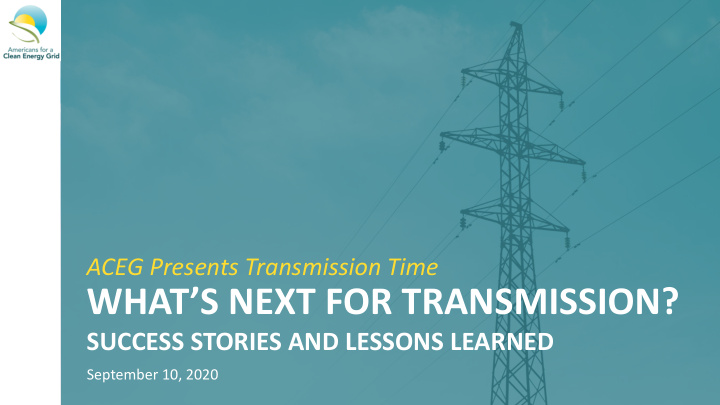



ACEG Presents Transmission Time WHAT’S NEXT FOR TRANSMISSION? SUCCESS STORIES AND LESSONS LEARNED September 10, 2020
INTRODUCTION TO AMERICANS FOR A CLEAN ENERGY GRID
ABOUT ACEG Americans for a Clean Energy Grid (ACEG) is the only non-profit broad-based public interest advocacy coalition focused on the need to expand, integrate, and modernize the North American high- voltage grid. National organization uniting diverse interests – environmentalists, utilities, renewable industry, transmission and technology companies. New Macro-Grid Initiative backed by Breakthrough Energy CleanEnergyGrid.org / @cleanenergygrid / Americans for a Clean Energy Grid
COALITION MEMBERS CleanEnergyGrid.org
Rob Gramlich Executive Director Americans for a Clean Energy Grid (ACEG) Jennifer Curran VP System Planning and Chief Compliance Officer Midwest Independent System Operator, Inc. (MISO)
Multi-Value Projects (MVPs) are major regional projects designed to reduce system congestion and meet renewable standards as known in 2011 Meet one or more goals: Reliably and economically enable regional public policy • Cost of $6.6 billion needs • $7.3 to $39 billion in net benefits over the next 20-40 years Provide multiple types of regional economic value • Total benefit-to-cost ratio of 1.8 to 3.1 • 15 of 17 projects are Provide a combination of in service regional reliability and economic value 6
The Multi-Value Project portfolio had some unique attributes that will be challenging to recreate in the present day A single portfolio to address needs • MVP Portfolio across MISO Cost shared pro rata to load • Planned prior to Order 1000 • Complete Pending / Underway 7
MISO member plans project a significant portfolio shift; differences across portfolios present additional challenges and opportunities Member A Member B Member C Member D 3% 5% 6% 9% 13% 32% 35% 34% 39% 47% Today 55% 38% 54% 16% 11% 2% 2% 2% 10% 14% 13% 17% 28% 7% 25% 11% 2030 5% 55% 37% 73% 18% 65% 18% Nuclear Coal Gas Renewables Other These figures show utilities’ total energy generated by fuel type, in megawatt-hours. Current figures compiled by S&P Global 8 Market Intelligence. 2030 projections compiled from IRPs, investor reports, and other sources.
Work to-date indicates expected portfolio changes will cause significant grid and stability issues requiring increased transmission investment Issues are driven by reduction in conventional • generation and the increase in inverter based (i.e. wind/solar/battery) generation Regional energy transfer increases in magnitude • and becomes more variable leading to a need for increased extra high-voltage line thermal capabilities Increase in renewable penetration causes different • dispatch patterns of conventional generators, leading to several dynamic issues Power delivery from weaker areas may need • transmission technologies equipped with dynamic- support capabilities 9
Transmission needs, overall transmission costs and generation costs can change based on where renewables are sourced, but planned generation costs will far outweigh transmission costs in any case 10
Transmission planning provides a comprehensive approach that covers short and long term needs to address generation additions, ongoing reliability, market efficiency and policy trends 11
There are conditions precedent for longer-term transmission plans to be approved and successfully developed Robust Cost Policy Business Allocation Consensus Case & Recovery Consensus that Analysis of subregional Costs assigned transmission is required to issues and solutions roughly address the subregional compatible with regional commensurate with and collective needs of the reliability and market benefits to each area footprint operations needs 12
THANK YOU FOR LISTENING! Questions?
Recommend
More recommend